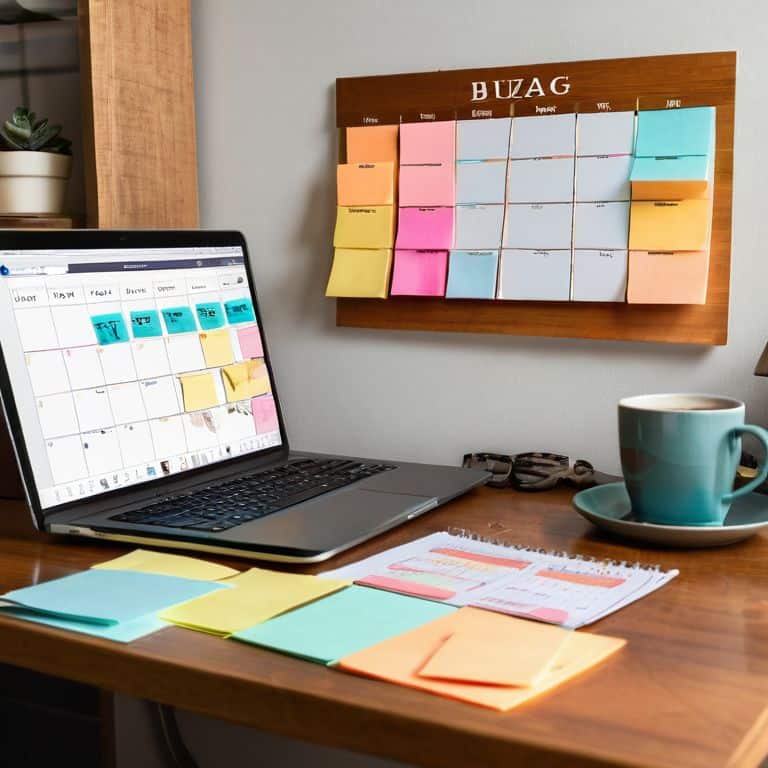I still remember the chaos of my early days as a blogger, trying to keep track of posts and deadlines without a clear plan. It was a nightmare, and I often found myself wondering how to create a content calendar that actually worked. The common advice was to just “plan ahead” and “be consistent,” but let’s be real, that’s not exactly a step-by-step guide. I’ve seen many bloggers struggle with this, and it’s often because they’re trying to follow generic templates or overly complicated systems. The truth is, creating a content calendar doesn’t have to be complicated – it’s all about finding a simple and flexible system that works for you.
In this article, I’ll share my own no-nonsense approach to creating a content calendar that will help you stay organized and focused. You’ll learn how to plan your content in advance, avoid last-minute scrambles, and actually enjoy the process of creating and publishing your work. I’ll walk you through the exact steps I take to create my own content calendar, from brainstorming ideas to scheduling posts. By the end of this guide, you’ll have a clear understanding of how to create a content calendar that fits your unique needs and helps you achieve your blogging goals.
Table of Contents
- Guide Overview: What You'll Need
- Step-by-Step Instructions
- How to Create a Content Calendar
- 5 Essential Tips for Creating a Content Calendar That Actually Works
- 3 Key Takeaways to Boost Your Blogging Productivity
- Planning with Purpose
- Putting it All Together: Your Path to Content Calendar Success
- Frequently Asked Questions
Guide Overview: What You'll Need

Total Time: 1 hour 30 minutes
Estimated Cost: $0 – $10
Difficulty Level: Easy
Tools Required
- Computer (with internet access)
- Spreadsheet Software (e.g., Google Sheets, Microsoft Excel)
- Calendar Template (optional)
Supplies & Materials
- Notebook (for brainstorming)
- Pencil (for writing down ideas)
- Paper (for printing out calendar template)
Step-by-Step Instructions
- 1. First, let’s get started by defining what a content calendar is and why you need one. A content calendar is essentially a planner or schedule that helps you organize and keep track of your content across all your platforms. It’s a simple yet powerful tool that can help you stay consistent and ensure your content is always fresh and engaging.
- 2. Next, you’ll need to choose a format for your content calendar. You can use a physical planner, a digital spreadsheet, or even a specialized tool like Trello or Asana. The key is to find a format that works for you and your team, and that you can easily update and access.
- 3. Now, let’s talk about planning your content. This is where you’ll decide what type of content you want to create, and when you want to publish it. Consider your goals, your audience, and your resources, and brainstorm ideas that will help you achieve your objectives. You can use a mind map, a list, or even a content idea generator to get started.
- 4. Once you have a list of content ideas, it’s time to create a schedule. Decide on a publishing frequency that works for you, and start plugging in your content ideas. Be sure to leave some buffer time in case things don’t go as planned, and consider using a content calendar template to help you get started.
- 5. With your schedule in place, it’s time to start creating content. Use your content calendar to guide you, and make sure you’re staying on track. Don’t be afraid to make adjustments as needed, and remember to review and revise your content calendar regularly to ensure it’s still working for you.
- 6. As you start publishing your content, be sure to track your progress. Use analytics tools to see how your content is performing, and make adjustments to your strategy as needed. This will help you refine your approach and ensure you’re getting the most out of your content calendar.
- 7. Finally, let’s talk about maintaining your content calendar. This is where the real work begins, as you’ll need to continually update and refine your schedule to ensure it stays relevant and effective. Set aside time each week to review and update your content calendar, and don’t be afraid to try new things and experiment with different formats and strategies.
How to Create a Content Calendar

As you start filling out your monthly content planning template, remember to leave some room for flexibility. Life can be unpredictable, and your content calendar should be able to adapt to changes. Evergreen content ideas are great for filling in gaps, as they remain relevant regardless of the time of year. Consider brainstorming a list of these ideas to keep on hand for when you need them.
When it comes to scheduling, don’t be afraid to explore different social media scheduling tools. Comparing features and prices can help you find the one that best fits your needs. You might also consider repurposing old content to reach new audiences. This can be a great way to breathe new life into old posts and reduce the amount of time spent on content creation.
To keep your content fresh and engaging, try incorporating seasonal topic ideas into your calendar. This can be especially helpful for marketing campaigns, as it allows you to tap into current trends and events. For example, a small business might focus on summer-themed content during the warmer months. By incorporating these types of content calendar examples, you can create a robust and engaging content strategy that drives results.
Monthly Planning Templates Made Easy
To make monthly planning a breeze, I recommend using a template. You can find plenty of free templates online, or create your own using a spreadsheet. The key is to keep it simple and tailored to your needs. I like to include columns for the date, topic, and type of content, as well as a checkbox to mark off completed posts.
Using a template will help you visualize your content for the month and ensure you’re posting consistently. You can also use it to plan ahead and schedule posts in advance, which is a huge time-saver. Trust me, once you start using a monthly planning template, you’ll wonder how you ever managed without one. It’s a simple yet powerful tool to help you stay organized and focused on your blogging goals.
Repurposing Old Content for New Audiences
Now that we’ve covered monthly planning templates, let’s talk about breathing new life into old content. Repurposing old content is a great way to reach new audiences and save time. Think about it: you’ve already put in the effort to create something valuable, so why not get the most out of it?
By repurposing old content, you can create new posts, social media updates, or even email newsletters that appeal to different segments of your audience. For example, you could turn a popular blog post into a video or infographic, making it more engaging and shareable. This way, you can reach people who prefer different formats and keep your content fresh and exciting.
5 Essential Tips for Creating a Content Calendar That Actually Works
- Start by identifying your core themes and topics to ensure consistency and focus across your content
- Set clear goals for your content, such as increasing engagement or driving traffic, to help guide your calendar’s structure
- Use a mix of evergreen and timely content to keep your calendar fresh and relevant, with a balance between planned and spontaneous posts
- Leave room for flexibility and adjustments as you go, since your content calendar should be a living document that evolves with your audience and strategy
- Review and revise your content calendar regularly to assess what’s working, what’s not, and make data-driven decisions to optimize your content’s performance
3 Key Takeaways to Boost Your Blogging Productivity
By creating a content calendar, you’ll be able to plan and organize your content in advance, saving you time and reducing stress in the long run
Repurposing old content can help you reach new audiences and breathe new life into your existing material, making your content creation process more efficient and effective
Using a monthly planning template can help you stay on track and ensure consistency in your publishing schedule, which is crucial for building and maintaining a loyal reader base
Planning with Purpose
A content calendar is not just a tool, it’s a mindset – it’s about being intentional with your content, understanding your audience, and creating a roadmap to connect with them in a meaningful way.
David Grant
Putting it All Together: Your Path to Content Calendar Success

As we’ve walked through the process of creating a content calendar, I hope you’ve seen how breaking down the task into smaller, manageable steps can make a significant difference. From understanding the importance of planning to using monthly planning templates and repurposing old content, each step is designed to help you build a robust and efficient content strategy. By following these steps, you’ll be well on your way to establishing a routine that works for you and your audience, making your life as a blogger much easier and more productive.
So, as you embark on this journey to create and utilize your content calendar, remember that consistency is key. Don’t be too hard on yourself if you miss a step or two – the important thing is to keep moving forward, always striving to improve and refine your approach. With patience, persistence, and the right guide, you can turn your content calendar into a powerful tool that helps you connect with your audience, build your brand, and achieve your goals. Keep in mind, the goal is not to create a perfect calendar, but to create a system that works for you, and that’s something to be incredibly proud of.
Frequently Asked Questions
How often should I review and update my content calendar to ensure it stays relevant and effective?
I recommend reviewing your content calendar at least once a week, and doing a deeper dive every month. This helps you stay on track, make adjustments, and ensure your content remains relevant and engaging. Think of it like sharpening a tool in my woodworking shop – regular tune-ups keep everything running smoothly.
What are some best practices for balancing evergreen content with timely, trending topics in my content calendar?
To balance evergreen content with timely topics, I recommend allocating 70-80% of your calendar to evergreen pieces and 20-30% to trending topics. This mix allows you to maintain a consistent foundation while still keeping your content fresh and relevant.
Can I use a content calendar to plan and schedule content across multiple social media platforms, or is it better suited for a single platform like my blog?
Absolutely, a content calendar can help you plan and schedule content across multiple social media platforms, not just your blog. In fact, it’s a great way to ensure consistency and coordination across all your online channels, saving you time and reducing stress. I’ll show you how to adapt your calendar for multi-platform use in the next section.
